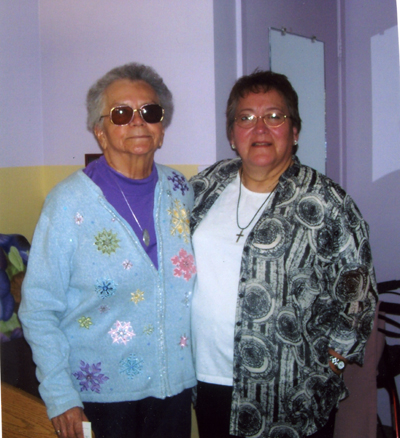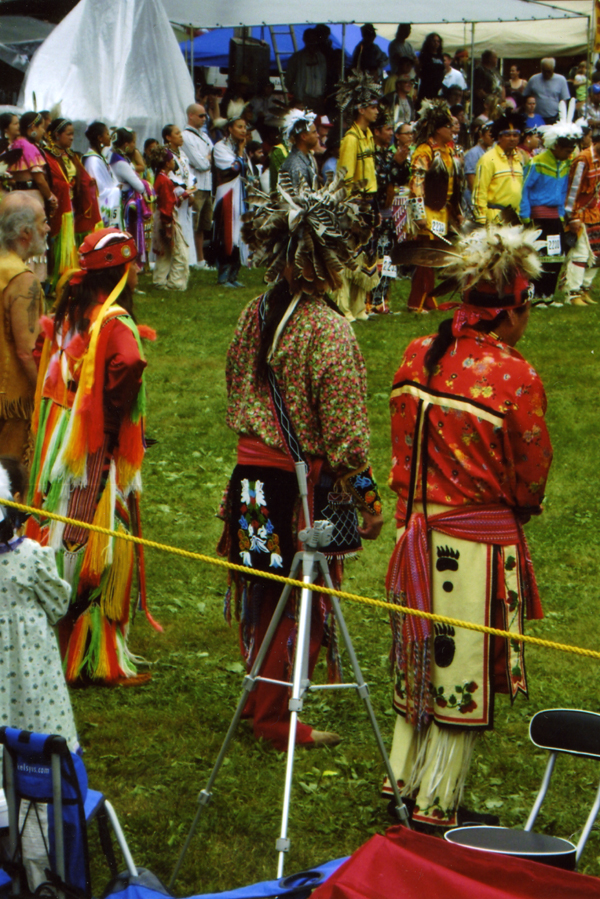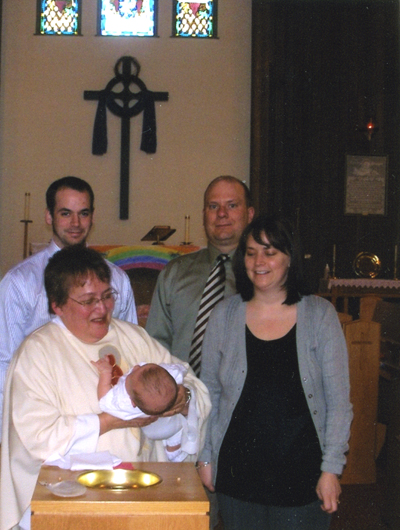
The Venerable Patricia Cleghorn, Archdeacon in the Diocese of Keewatin, and present rector of St. Lukes Anglican Church in Dryden was born on the Six Nations of the Grand River Territory, near Brantford, Ontario. She belongs to people of the Six Nations, known collectively as the Iroquois Nation and is made up of six tribes which are the Cayuga, Onondaga, Seneca, Oneida and the Delaware. Pat was born into the Onondagas.

The Six Nations Reserve is one of the largest reserves in Canada. After the War of 1812, being allies of the British, The Iroquois were driven northward and out of the United States. The traditional hunting areas and way of life were gone. In recognition of the fact that they fought alongside the Commonwealth against the Americans, Queen Victoria ceded the Iroquois Nation the territory six miles long and six miles wide along the Grand River in southern Ontario. Every year, on the 21st of May, her birthday is celebrated and the band council gives out bread and cheese to every band member. People return from great distances to join in this celebration. As a result of the immense new territory and with changing times, the Iroquois adapted from a hunting and warrior way of life to a sedentary agricultural lifestyle.
As they became acculturated, their system of beliefs also changed. They became divided according to their religious orientation. Some were converted to Christianity by missionaries and adopted western values and governance. Others, who retained their traditional ways of belief and lifestyle, are known as People of the Longhouse. Today they co-exist in relative harmony but it was not always so. The Longhouse people continue to this day to celebrate their belief system in the Creator and in nature by celebrations and rituals which have been passed down from previous generations. As in many cultures, belief systems can be divisive and some of this still exists. Christian and Longhouse do not participate in each others faith rituals however most of the people respect each others ways. There is also another tribe which was granted permission to reside in their territory. These are the Chippewa, and some of this tribe decided to continue moving northward and today are known as the Ojibwa.
Pat's mother was raised in the traditional way and understood the Cayuga language; her father was raised in a Christian family according to the Anglican tradition. He also attended residential school at the Mohawk Institute in nearby Brantford. Pats father called the school the mush hole, a reference to the food that was served. Though Pat remembers being curious about the Longhouse belief system especially as her mother continued to maintain family ties, she was not encouraged in this curiosity. She particularly remembers her mother returning from feasts with baskets of food (corn soup, bannock, jams etc.). Dating and intermarriage was frowned upon by the parents and elders because of differing belief systems.
Reverend Pat on the right with her mother on the left

The early Iroquois people inhabited a long multi-family building made from birch saplings. It was a long barrack-like building sub-divided into individual living spaces and had two levels. The upper level was for sleeping and the lower level was for activities of daily life. The upper floor was made by interwoven birch tree branches covered with bear skins or deer hides. Each family had its own fire pit for cooking and heating, there was an opening at the top of the structure to let the smoke escape outside. This type of building now exists only as a tourist attraction. Today it is a long rectangular wooden building, very plain inside with a row of wooden benches that run the length of the outer walls. Clan symbols decorate the walls of this modern day longhouse. Pat belongs to the Turtle clan; this type of identity is passed down through the father. There is a cook house and cemetery attached. The cemetery has wooden markers since headstones of cement or granite are believed to hold down the spirit and prevent it from rising to the Creator. The center of the building is used for speaking the Iroquois history. Their history is an oral history and the story of the people is passed down by recognized speakers, individuals who have been chosen by the elders to learn the history and ways of the people. It is said that the Iroquois people will survive until there is no one left for the speaker to tell the story to and at that time the last speaker will walk the Milky Way to the Creator. There is a longhouse for each tribe where festivals, weddings, funerals and seasons of the agricultural year are celebrated. There are four agricultural seasons or festivals during the year. In the spring there is a celebration for the end of winter and for the rebirth of nature, a time of planting. In June, a strawberry festival occurs as the land becomes ripe with gifts from the Creator and to celebrate the summer solstice. A fall festival celebrates the harvest, a time of thanksgiving and the winter festival celebrates the approach of the winter solstice, the shortening of days and a time of preparation as the earth goes to sleep.
Although born on the reserve, Pats family moved to Buffalo, New York when she was three years old. (Pats father was an iron worker and they moved where there was employment). Then at the age of eleven her family moved back to the reserve. Fitting in and being accepted was not easy because the other children saw Pat and her sisters as coming from the white world. During her high school years, at a school just outside of the reserve, it was just the opposite; here she was viewed as too Indian. Belonging was not a word that she understood. After grade thirteen, she attended St. Josephs school of Nursing in Hamilton, Ontario.
While at St. Josephs Hospital, she was introduced to the Roman Catholic Church and coming from an Anglican background found the differences and similarities quite fascinating. As she studied under the nursing sisters, she became aware of the spiritual side of individuals and of the responsibility for caring and nurturing this aspect of a person. It was to stand her in good stead in her future career in the church. Unfortunately, racism was also a reality here as well. She was repeatedly reminded by the Nursing Director that as an Indian she had the responsibility of being in good standing as she represented her people. She was only the second native person to attend this particular school of nursing. This caused some confusion for Pat as none of the other ethnic groups were spoken to in this way and again she felt centered out by virtue of her race.
After two years of nursing, she met her future husband Chris, a young English man attending university in Hamilton. They soon moved to England and began a family. Pat remained active in nursing and in the church. Eventually, they came back to Canada in 1976 and by this time had two young children in tow. Three years later, their family was completed by the birth of their third child. Shortly after this, Pat began to discern a call to ordained ministry in the Anglican Church.
2009 Six Nations pow-wow

While working as a nurse at the McMaster Hospital, which encouraged the common link of caring for others, she explored this call to ordination. Encouraged by her family and accepted by the Church, Pat returned to school to work towards a university degree. In the middle of all this her family moved to Dryden, Ontario (Where is that?, she asked) where continued education was more difficult to obtain. Once again the subject of her being native arose as her Bishop promptly arranged for her to fly up to the northern reserves to meet the natives. She was again being asked to be a role model, this time to the native women whom the Bishop felt needed to see how another native woman could live. Thoroughly enjoying her short visit to Kingfisher, Pat came away learning more about life on a reserve in Northern Ontario.
Pat learned many of the spiritual traditions of the Ojibwa while studying at Lakehead University. One of her supervisors, a Swampy Cree elder, introduced her to the sweat lodge, smudging and smoking a pipe. Once, while in a sweat lodge, she had a vision of herself flying on the back of an eagle and looking down on the countryside. Pat understood this to be a confirmation of her call to being an ordained minister. She also found many similarities in the traditional ways that did not conflict with her own Christian theology. Pat has always accepted mysticism in life and the connection with nature which is a part of who she is as a native person. She has vivid memories of her ordination to the diaconate when she knelt in front of the Bishop and sensed a large bird passing over her head and she could feel the flapping of its wings. It was only several days after the event that other individual told her that they too had the same sensation. Furthermore, an elder who had also was at the ordination said that an eagle circled the room as the service was conducted. This was a confirmation of her call to ordained ministry.
Traditional Men's Dress of the Iroquois People. Picture was taken at the 2009 Pow-wow in Southern Ontario

She feels it is part of her responsibility to advocate for her people; she has taught her children to address unfairness and racism no matter how covert it is. As a retired R.N. she has conducted in-services on understanding the nuances of a native patient and how to recognize their unique individuality. For example, Pat recommends to doctors and nurses to be direct and insistent when questioning a patient. A traditional native patient may trivialize their malady and answer the questions so as not to offend the health provider. In additioon, When asked, she has spoken to public school class rooms to explain the Iroquois way of life which is not so different from that of the Ojibwa. Today is particularly concerned about how natives are perceived in the community of Dryden; she feels that subtle and not so subtle racism does still persist.
As a person of First Nations descent, Pat offers a unique insight into the present situation that First Nations people find themselves in. First of all, native culture is not free of the me, me mentality of our present society. There is in-fighting, mistrust and nepotism in many First Nations communities and these are stumbling blocks to the betterment of their lifestyle. Finally, substance abuse, alcoholism and dysfunctional family life are only too prevalent.
Pat believes that the education of the young people and full participation in mainstream society are the keys to improving the situation that First Nations are in today. The fact that people are isolated on reserves is a significant contributor to present day problems. One of the most successful communities is Norway House in northern Manitoba. They have made integration of their young people a major priority. Their children travel frequently to Winnipeg, they are encouraged to be outgoing and to participate in sports tournaments and cultural events on and off the reserve. Pat adds that it is vogue today for predominately non-native school boards to try and create programs unique to native children. She feels that there is a risk that this will only separate them even further from the mainstream.
The most successful First Nations communities have achieved their success because the elders have endeavored to educate themselves and have adopted many of the administrative and business skills necessary to do succeed in Canadian society. When they return to their home they are equipped to make the necessary changes that will benefit their community. As important as it is for mainstream Canadians to understand and to be sensitive to the present plight of Native people, Native people must accept responsibility for their family life and set boundaries for their children. Finally, it is not enough to continue depending on the government to take care of those living on reserves. First Nation people need to continue to work towards self-government and its attending responsibilities.
Arch Deacon Pat baptizing her grandson
